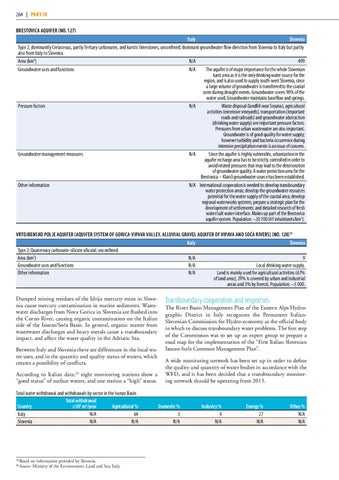264 | PART IV Brestovica aquifer (No. 127) Italy Slovenia Type 2; dominantly Cretaceous, partly Tertiary carbonates, and karstic limestones; unconfined; dominant groundwater flow direction from Slovenia to Italy but partly also from Italy to Slovenia. Area (km2) N/A 499 Groundwater uses and functions N/A The aquifer is of major importance for the whole Slovenian karst area as it is the only drinking water source for the region, and is also used to supply south-west Slovenia, since a large volume of groundwater is transferred to the coastal zone during drought events. Groundwater covers 90% of the water used. Groundwater maintains baseflow and springs. Pressure factors N/A Waste disposal (landfill near Sezana), agricultural activities (extensive vineyards), transportation (important roads and railroads) and groundwater abstraction (drinking water supply) are important pressure factors. Pressures from urban wastewater are also important. Groundwater is of good quality for water supply; however turbidity and bacteria occurrence during intensive precipitation events is an issue of concern. Groundwater management measures N/A Since the aquifer is highly vulnerable, urbanization in the aquifer recharge area has to be strictly controlled in order to avoid related pressures that may lead to the deterioration of groundwater quality. A water protection area for the Brestovica – Klariči groundwater source has been established. Other information N/A International cooperation is needed to: develop transboundary water protection areas; develop the groundwater resources potential for the water supply of the coastal area; develop regional waterworks systems; prepare a strategic plan for the development of settlements; and detailed research of fresh water/salt water interface. Makes up part of the Brestovica aquifer system. Population: ∼20 700 (41 inhabitants/km2). Vrtojbensko polje aquifer (aquifer system of Gorica-Vipava valley, alluvial gravel aquifer of Vipava and Soča rivers) (No. 128)19 Italy Slovenia Type 2; Quaternary carbonate-silicate alluvial; unconfined. N/A 9 Area (km2) Groundwater uses and functions N/A Local drinking water supply. Other information N/A Land is mainly used for agricultural activities (67% of land area); 29% is covered by urban and industrial areas and 3% by forests. Population: ∼5 000. Dumped mining residues of the Idrija mercury mine in Slovenia cause mercury contamination in marine sediments. Wastewater discharges from Nova Gorica in Slovenia are flushed into the Corno River, causing organic contamination on the Italian side of the Isonzo/Soča Basin. In general, organic matter from wastewater discharges and heavy metals cause a transboundary impact, and affect the water quality in the Adriatic Sea. Between Italy and Slovenia there are differences in the local water uses, and in the quantity and quality status of waters, which creates a possibility of conflicts. According to Italian data,20 eight monitoring stations show a “good status” of surface waters, and one station a “high” status. Total water withdrawal and withdrawals by sector in the Isonzo Basin Total withdrawal Country ×106 m3/year Agricultural % Italy N/A 64 Slovenia N/A N/A
19 20
Based on information provided by Slovenia. Source: Ministry of the Environment, Land and Sea, Italy.
Transboundary cooperation and responses
The River Basin Management Plan of the Eastern Alps Hydrographic District in Italy recognizes the Permanent ItalianSlovenian Commission for Hydro-economy as the official body in which to discuss transboundary water problems. The first step of the Commission was to set up an expert group to prepare a road map for the implementation of the “First Italian Slovenian Isonzo-Soča Common Management Plan”. A wide monitoring network has been set up in order to define the quality and quantity of water bodies in accordance with the WFD, and it has been decided that a transboundary monitoring network should be operating from 2015.
Domestic % 5 N/A
Industry % 4 N/A
Energy % 27 N/A
Other % N/A N/A
